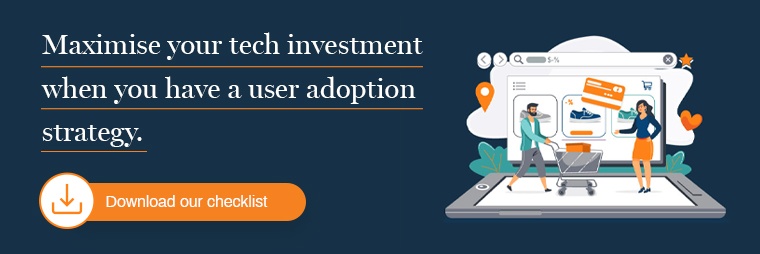So you’ve got a new, snazzy e-commerce website. And it looks great. But there’s just one thing - it’s not performing as well as you expected. Maybe you’re not getting enough traffic or your website visitors aren’t converting. Whatever the reason, don’t worry - it’s solvable.
Here are some top reasons why your B2B e-commerce website isn’t working, plus some tips on how you can fix it.
- Your website isn’t search engine-friendly
- You haven’t provided enough information
- You’ve provided too much information
- Your website isn’t multi-device friendly
- Your website doesn’t have a goal
- Your forms are too time-consuming to fill
- You’re using a B2C e-commerce platform to create a B2B experience
Your website isn’t search engine-friendly
Search engine optimisation (also known as SEO) is the practice of ensuring your online content (product pages, ‘About us’ page, blogs etc) rank on search engines. It’s not enough to simply have a search box on your website. Although it would help your website visitors find what they need, how are you going to get those visitors on your site in the first place?
Enter SEO. Analyse your customer preferences and purchase histories to create ideal customer profiles. Then, use that knowledge to make educated predictions on what your ideal customers would enter into a search engine. What would they Google/Bing etc? What problems are they looking to solve? What questions are they asking?
Sprinkle these keywords throughout your website pages, in the page titles, headings and body copy. That will help your website rank both in search engines and optimise your website’s internal search functionality.
You haven’t provided enough information
The main purpose of your e-commerce website may be to drive sales but it shouldn’t be all about that. Why? Because simply putting up products for sale isn’t the only thing that will persuade people to buy from you.
This is what will:
- Case studies - to prove that your company can deliver the results you claim on your website
- Blog posts, online articles, eBooks and other downloadable assets - to show off your knowledge and ‘thought leadership’ status
- Accurate product descriptions - to help your prospects and leads really understand what they’re buying before they commit to the purchase
- A variety of high-quality imagery, video and other media - to keep website visitors engaged
In other words, you should be offering a wide range of content. Combine this with your SEO strategy and you can attract the right people to your website without having to actively look for them.

You’ve provided too much information
On the flip side of the above point, if your website is offering too much information, it can be overwhelming for your visitors. Combat this by ensuring:
- Landing pages serve one purpose only (e.g. promotes just one marketing offer, rather than multiple)
- Your content is grouped into relevant categories
- Your content is appropriately tagged so it’s easy to find
Your website isn’t multi-device friendly
More and more people are browsing and purchasing via mobile than ever before. But of course, there will still be some who prefer desktop. Some may even prefer tablet. If your website isn’t optimised for these different devices, you may be putting people off.
Particularly within the B2B space, people want more agility and flexibility. They’re searching and purchasing while on-the-go so you need to be available, presenting the right answers when they need you to.
So, before you launch any new B2B website, make sure you test it across all devices.
Your website doesn’t have a goal
If your website isn’t solving a specific problem and creating an end goal for your visitors, they will seldom convert. No matter how brilliant and unique your products/services are.
Rather than using your website as an online billboard, use it to speak directly to your visitors and address their pain points. How will you resolve them? Why is your business the answer? What do you have to prove that you can help them achieve their goals?
Tip: Be clear and get straight to the point. Your visitors will see straight through any ‘waffle’.
Your forms are too time-consuming to fill
Although it can be tempting to create forms with multiple fields, remember that less is more. Always. Yes, you want to get to know your customers and discover as much as possible about them. But do you really need to know their maiden name? Or their birthday?
Long forms will only put your visitors off!
Only ask for what you need. For most cases, you’ll need:
- Name
- Company
- Email address
- Industry
You’re using a B2C e-commerce platform to create a B2B experience
The phrase, ‘trying to fit a square peg in a round hole’, has never rung truer when it comes to this point. They might share some similarities but B2C and B2B experiences aren’t the same. Not really.
For example, the B2B buying journey tends to be longer and more complex than the average B2C. There are usually more stakeholders involved in the sign-off and more research is needed before they decide to commit to a purchase.
Your B2B e-commerce website needs to reflect these differences so using a B2C e-commerce platform won’t be enough.
You need a platform that can help you cater to specific B2B customer pain points, such as:
- Product/solution configurators
- Custom pricing builders
- Ability to adjust units of measure

And then there’s the case of whether your e-commerce platform can integrate with your other core business systems, such as your ERP or your CRM. The right platform shouldn’t require a network of complex integrations that will be costly and time-consuming to set up. And let’s not discuss the complications you may encounter if you need to upgrade your solutions…
Find the right e-commerce platform for your business by:
- Understanding what your business needs are and mapping them to the platform’s features. Can the platform support you?
- Looking at the integration requirements between your back office systems and the e-commerce platform. Are they a necessary function? Or are they only benefitting potentially unnecessary legacy business rules?
- Researching e-commerce platforms and comparing your best-in-class options. Can you see why B2B-specific e-commerce platforms can meet your needs more effectively than the B2C alternative?
Episerver’s Commerce Cloud is a complete commerce suite, designed for B2B companies who rely on e-commerce. From straight-forward content management that requires no development expertise to intuitive A/B testing and centralised multi-site management, discover Commerce Cloud’s features in more depth here.
Are you approaching technology adoption the right way?
To truly maximise your e-commerce technology investment, you must tackle user adoption. In our short checklist, we cover our 10 top tips to help prioritise the right things at the right time.
Learn more via the button below.


